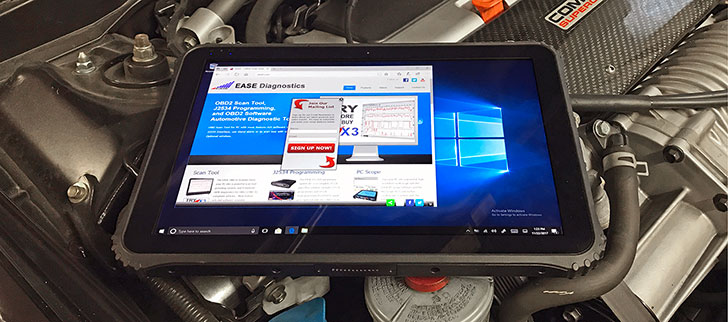|
Teguar TRT-5180-12
For when you need a tough Windows tablet with some extra screen real estate and plenty of connectivity for complex work in the field
(by Conrad H. Blickenstorfer)
Teguar is a catchy name but not necessarily a familiar one when contemplating the purchase of a rugged tablet. That may soon change as the Charlotte, North Carolina, based company is a hard-charging provider of industrial and medical computers that's rapidly moving up on the Inc. 5000 list.
Launched in 2010 by a Swiss native with years of experience in industrial computer systems, Teguar prides itself in combining American adaptability and technological leadership with Swiss precision, quality, and attention to detail. What caught our eye was their new Intel Kaby Lake-powered rugged 12.2-inch tablet with optional 2-in-1 hybrid functionality.
While the majority of currently available rugged tablets are in the 10-inch class, there's growing customer interest for larger tablets that are more suitable for complex Windows 10 applications. The image below shows the Teguar TRT-5180-12 from the front and all four sides.
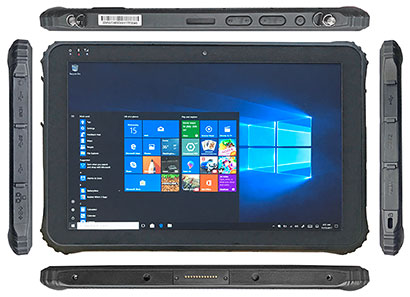
Measuring 12.6 by 8.5 inches, the TRT-5180-12 has the same footprint as the 12.9-inch iPad Pro. It's just under an inch thick and weighs about 3.3 pounds. This is a serious piece of tablet computer equipment, evidenced not only by a very nice IPS capacitive multi-touch display with perfect viewing angles and the same sharpness as a Dell UltraSharp 24-inch 4k monitor, but also by the kind of comprehensive onboard connectivity that many customers need and require. As far as the latter goes, that makes the Teguar the exact opposite of the big iPad Pro with its single tiny lightening port.
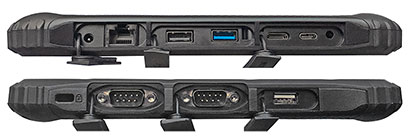
The picture above shows the available interface ports on the left and right sides of the TRT-5180-12 with their protective covers open. On the left side you find two full-size USB ports, a Type C USB 3.0 port, a gigabit RJ45 LAN jack, a mini-HDMI port, and power. On the right side is another USB 2.0 port and, for legacy connectivity, both a RS232 and a RS485 serial port. That is more than what the large-tablet competition offers.
This extensive I/O is protected by six separate flexible I/O port plugs. Each is tethered to the unit with a thin rubber anchor and each has a compression seal. It's crucial for ingress protection that all those covers are seating tightly. To open them you must pull on tiny fingernail-busting flaps; not an optimal solution.
Excellent 2-in-1 hybrid implementation
While iOS and Android were designed for touch, Windows wasn't. Which means sometimes it's good to have a real, physical keyboard to work with Windows on a tablet. That explains the growing popularity of "2-in-1" designs with detachable keyboards so you can use the tablet both as a tablet and as a notebook computer.
Coming up with a 2-in-1 design that really works isn't easy. The designers of the TRT-5180-12 aced that challenge with their optional keyboard and kickstand. The keyboard is thin and light, but has a full-scale QWERTY layout that works just as well as the superb Apple iMac "magic" keyboards. It quickly screws on to the bottom of the TRT-5180-12 tablet, talks to the tablet via a pogo pin connector (so no Bluetooth hassles), and even offers two extra USB ports.
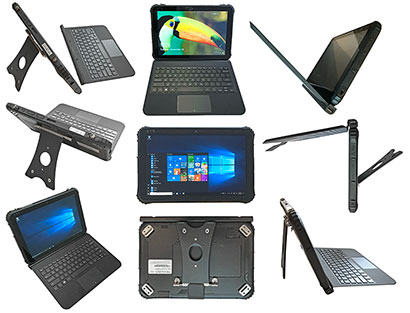
The image compilation above shows the full functionality of the 2-in-1 approach. You can use the TRT-5180-12 as a tablet without the extra weight of a conventional integrated keyboard. While many 2-in-1 solutions are top-heavy and thus unstable when used as laptops, the TRT-5180-12's simple screw-on kickstand solves that problem and allows easy angle adjustment.
The only questionable design decision here is an magnetic fabric flap that forlornly hangs off the bottom of the keyboard to hold the tablet and keyboard together when closed in laptop mode. Overall, this optional keyboard and stand make for a compelling 2-in-1 solution.
Impressive construction
It's not easy to pack a full Windows PC plus battery into a slender tablet body, especially when that body also has to be tough and rugged and pack a full complement of wired ports. So we took a look inside to see how the TRT-5180-12 designers handled the task.
Opening up the Teguar TRT-5180-12 is easy, if you have the patience (and tools) to undo about three dozen tiny Torx T-6 and Philips screws. Once those are out, the two black polycarbonate plastic halves easily come apart, with just the stereo speaker wires needing to be disconnected between the sides. Sealing between the halves is via a tongue-and-groove design with replaceable 3D rubber pressure seal.
The big Teguar tablet has a full-size and very solid coffered magnesium chassis that extends over the entire footprint of the tablet. This makes for a very strong (and meticulously designed and manufactured) structure and foundation for all electronics.
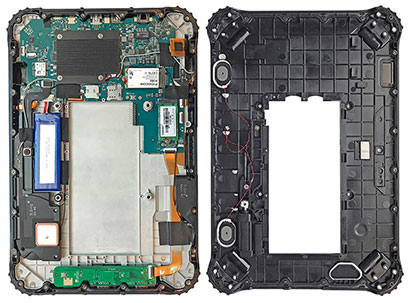
The rechargeable, externally accessible Lithium Polymer battery packs 46.6 watt-hours. It fits flush into the battery compartment that also provides access to the unit's SIM and SD cards. The battery, which locks in place with a spring-loaded lever and is hot-swappable thanks to an internal 7.4 watt-hour backup battery, has a recessed rubber seal around its perimeter.
The interior itself is spacious and so there was no need for excessive electronics miniaturization. That means standard PC modules such as the Foresee 128GB SATA III 6gb/s M.2 solid state disk, a Fibocom WWAN module, a uBlox NEO-7M GNSS module, etc. I/O is edge-mounted on one side of the tablet, and housed on a separate I/O daughter board on the other side. This approach allows for easy customization.
The TRT-5180-12 is a fanless design. Thermal management employs the big magnesium frame that acts as a heat spreader and dissipator, and there is also an additional small finned heat spreader on the CPU. Overall, the interior of the Teguar tablet impresses with solid construction, strong materials, and a logical layout.
Performance
Large-screen tablets are for serious Windows work and customers expect enough performance to do just that. Which isn't easy in a lightweight, fanless tablet. While smaller lower-end tablets usually come with Atom processors, their performance can be marginal for demanding work. Intel's higher-end Core processors pack enough punch, but generate more heat than a light, fanless design can handle.
The TRT-5180-12's solution was to use a power-miser Intel "Y" class processor that generates not even a third as much heat as even Intel's "ultra-low voltage" "U" class chips (4.5 vs 15 watts). Yet, the dual-core Intel M3-7Y30 is a full-fledged member of Intel's 7th generation of "Kaby Lake" processors. How can it produce so little heat? By idling along with a default clock speed of just 1.00GHz (but still being capable of a maximum turbo speed of 2.60GHz). It's like a small displacement turbo combustion engine that can make big power when needed, but still gets great gas mileage.

We ran the TRT-5180-12 through our standard benchmark suites and it scored an overall PassMark 6.1 score of 1,694. That's about 2.5 times as fast as a modern Intel Atom-powered tablet. And it can be almost as quick as a Kaby Lake "U" Series device. We say "can be" because peak power of "Y" Series chips is not as predictable, and more heat-sensitive, than that of the the hotter-running "U" Series chips.
Built-in cameras
Like virtually all modern tablets, the Teguar has front (2-megapixel) and rear (5-megapixel) cameras. The included standard Windows Camera app doesn't provide many options and settings, and our sample pics defaulted to 2,560 x 1,920 pixel (4.9-megapixel). The camera worked fine, but the standard Windows camera app is very basic and so we'd highly recommend using a third party camera app. Click on the sample picture compilation to see it in full size.
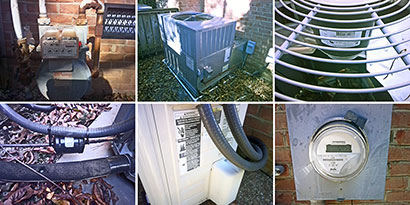
As regular readers of RuggedPCReview.com know, we have mixed feelings about cameras integrated in rugged handhelds and tablets. Having documentation and conferencing cameras right in a tool for the job can be very helpful, but modern smartphones simply do a better job.
Ruggedness
The purpose of a rugged tablet is to bring computing power to the field and on the job, even if that job is in an inhospitable environment. That means the device must be able to handle the kind of spills, bumps, grinds and splashes that might happen out there, and the big Teguar tablet certainly looks like it can.
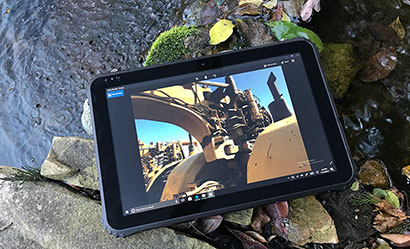
As is, there isn't a lot in terms of environmental specs. The Teguar TRT-5180-12 has a very wide operating temperature range of -14 to 122 degrees Fahrenheit (-10° to +50°C), and ingress protection is at the IP65 level. That means the tablet is fully dustproof and can also handle low pressure water jets from all directions. The display uses high-strength Corning Gorilla Glass, and the glass surface is very slightly recessed into the housing, which provides a bit of extra protection against breakage.
Documentation claims that the "tablet complies with the MIL-STD-810G standards." We'd like to see more specifics.
Bottom line: Teguar TRT-5180-12 12.2-inch rugged tablet
There are times when you need a tough Windows tablet with enough ports and some extra screen real estate for complex work. There aren't too many of those around, but Teguar's TRT-5180-12 is one of them. Crisp, bright 12.2-inch multi-touch display with optional active pen, excellent onboard connectivity, an Intel 7th generation Core processor, very functional optional 2-in-1 keyboard and kickstand, and rugged enough to take on the job, wherever that may be. -- Conrad H. Blickenstorfer, November 2017
|



